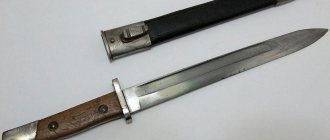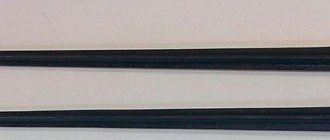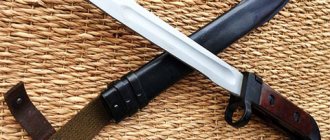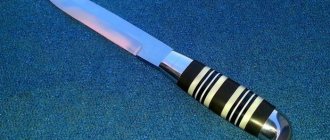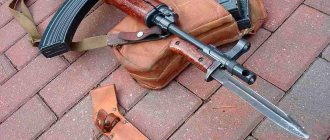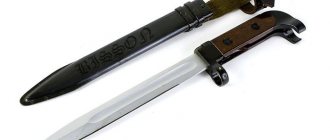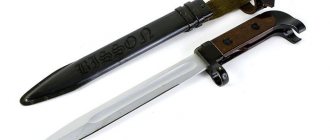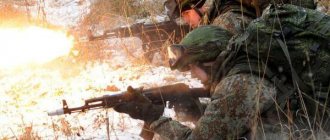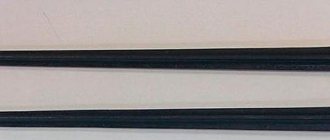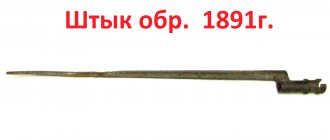Germany during World War II
The period in history since World War II designates Germany as the "German Reich" Deutsches Reich until 1943 and then the "Greater German Reich" Großdeutsches Reich. Russian historians use terms such as “Hitler”, “Nazi”, “fascist” and “Third Reich” to refer to Germany. The Greater German Reich ceased to exist after the defeat in World War II, and some security forces and the National Socialist German Workers' Party were recognized as criminal organizations.
On September 1, 1939, the German Army invaded Poland. During the period from 39 to 41, German troops defeated Poland, Denmark, Luxenburg, the Netherlands, France, Greece, Yugoslavia, Norway and Belgium. On June 22, 1941, the invasion and seizure of part of the territory of the Soviet Union took place.
A regime of intimidation took place in the occupied territories. The persecution and extermination of Jews began, and in some areas the complete extermination of the local non-Jewish population began in order to suppress partisan movements.
The unconditional act of surrender was signed on May 8, 1945 in Reims. May 9 was declared the day of cessation of hostilities, and on May 23 the government of the Third Reich was arrested in Flensburg.
According to the latest data, German losses during the Second World War amounted to 8 million 876 thousand people.
Bayonet | USSR
Four-sided needle bayonet for the Mosin rifle mod. 1891/1930
The bayonet is based on the bayonet for the Berdan rifle mod. 1870 and was put into service in 1891. In 1930 it was modernized. The blade is needle-type, straight, tetrahedral, with fullers on all edges. The tip of the blade is cut in the shape of a screwdriver. A tube with an L-shaped slot going from top to left. The posterior end of the tube is thickened. The neck is short, tetrahedral. A spring latch is mounted at the base of the blade, which secures the bayonet when it touches the base of the front sight. By the beginning of the war, about 25 million bayonets were in service. Performance characteristics of the bayonet: total length -500 mm; blade length - 430 mm; blade width - 17.7 mm; tube length - 71.3 mm; the inner diameter of the tube is 15 mm.
Folding bayonet for Mosin carbine mod. 1944
The bayonet was created on the basis of the bayonet mod. 1891/30, but was shorter and integral to the carbine. It was produced with two latch options. The first version was produced in 1943-1945. and was distinguished by one protrusion on the base of the bayonet, permanently attached to the barrel of the carbine, tightly fixing the bayonet only in the firing position. The second version was produced from 1945 and was distinguished by two protrusions on the base, which fixed the bayonet in both combat and traveling positions. The blade is needle-type, straight, tetrahedral, with fullers on all edges. The tip of the blade is cut in the shape of a screwdriver. A spring latch in the form of a sleeve with a ring is put on the barrel when the bayonet is moved to the firing position. When transferred to the stowed position, the latch-sleeve with the ring moves forward, and the bayonet tilts to the right, back to the fore-end. Performance characteristics of the bayonet: total length - 380 mm; blade length - 310 mm; blade width - 16.5 mm; the internal diameter of the tube is 14.4 mm.
Single-edged bayonet for Mosin rifle
A bayonet with a short blade was used with a Mosin rifle mod. 1891/30. Single-edged blade, with a fuller on both sides. A tube with an L-shaped slot going from top to left. The posterior end of the tube is thickened. The neck is short, tetrahedral. A spring latch is mounted at the base of the blade, which secures the bayonet when attached to the base of the front sight; the sheath was not attached to the bayonet. The bayonet made it possible to deliver circular slashing blows and, on the reverse stroke, to hit with the side surface of the butt. However, the piercing capabilities of the old “Russian bayonet” have noticeably decreased. Performance characteristics of the bayonet: total length - 340 - 360 mm; blade length - 265 - 285 mm; blade width - 27 mm; tube length - 72 mm; the inner diameter of the tube is 15 mm.
Bayonet for the ABC-36 rifle
The bayonet was used with the Simonov automatic rifle mod. 1936 (ABC-36). It was attached to the bar under the rifle barrel using a hook in the back of the blade's shank and a slot in the head of the handle. In the combat position, the bayonet was fixed by a hook under the barrel with a special groove located in the back of the handle. The unfixed bayonet played the role of a bipod, which could be stuck into the ground to stabilize the rifle in automatic fire mode. The bayonet blade is single-edged, with a beveled relatively longitudinal fuller and a rectangular recess on the heel of the blade on both sides. The handle is formed by two corrugated wooden cheeks, fastened to a movable frame with one screw. The sheath is steel, with two brackets for a leather belt. In total, about 66 thousand units were produced. Performance characteristics of the bayonet: total length - 450 mm; blade length - 335 mm; blade width - 25 mm.
Bayonet for the SVT-38 rifle
The Tokarev self-loading rifle (SVT-38) was equipped with a bayonet. The blade is single-edged, with one fuller on both sides. The handle is formed by two wooden cheeks fastened to the shank with two screws. fastened to the shank with two screws. For 1938-1940. About 300 thousand units were produced. Performance characteristics of the bayonet: total length - 480 mm; blade length -360 mm; blade width - 28 mm; the inner diameter of the ring is 14 mm.
Bayonet for the SVT-40 rifle
The bayonet was created on the basis of the SVT-38 bayonet and was used with the Tokarev SVT-40 and AVT-40 rifles.
It differed from the prototype in the length of the blade. The bayonet blade is single-edged, with a fuller on both sides. The handle is formed by two wooden cheeks, fastened to the shank with two screws. The head of the handle has a T-shaped groove and a spring latch with an internal spiral spring, and the spring latch button has a safety collar. The cross is straight with a ring for the barrel on the butt side of the blade. The sheath is steel, with two belt clips. By the end of the war, more than 1.5 million units were produced. Performance characteristics of the bayonet: total length - 360 mm; blade length - 240 mm; blade width - 24 mm; the internal diameter of the ring in the cross is 14 mm. Share to:
World War II Antiques. Germany
The Hitler period in German history left behind many striking and characteristic objects. Awards, for example, at this time became national (before the Nazis came to power, they were awarded by the state government and were of a purely territorial nature). A number of changes were made in accordance with the new attributes. Before the start of the war, Hitler personally presented all types of awards; later this right was vested in the military command.
During the period of the war of action, industry in the military sphere underwent crazy growth. A huge number of daggers, daggers, helmets, belts and buckles and other elements of uniforms and equipment have survived to this day and are presented in our catalog. Interior items and watches also have great collectible value and best convey the spirit of that time.
The exhibits are carefully preserved in excellent condition and prepared for further storage. You can purchase a piece of memory about one of the largest wars in history, which only becomes more valuable every year.
Daggers and dirks of Nazi Germany
Perhaps, in the entire history of uniform weapons, there has not been such a variety of paraphernalia and weapons as Germany during the Third Reich was distinguished by. Today, historians confidently state that numerous ceremonies and processions developed by Nazi ideologists played a truly important role in Hitler’s rise to power.
SS dagger
The introduction of special types of bladed weapons into the uniform with attributes of various military and paramilitary organizations was of great importance (this was especially true for German uniforms during the Second World War). By looking at sabers and daggers from the period of the Third Reich, it was possible to determine the rank, branch of service and even the regional affiliation of their owner.
In 1933, Adolf Hitler, the newly-crowned Fuhrer of the German nation, gathered in Berlin the heads of the most significant companies in Solingen (at that time the world center of the knife industry) and ordered the development of daggers and sabers for the uniforms of numerous organizations and the German army. All Nazi symbols were to be used in new models of uniform weapons.
Luftwaffe dagger model 1937
The first approved model was the SA dagger of the 1933 model for the unit of the same name (Sturmabteilung), the prototype of which was the medieval Swiss Holbein. The upper part of the brown handle (in accordance with the color of the uniform) was decorated with an emblem in the form of runic S and A, stylized as lightning bolts. The inscription “Alles fur Deutschland” (“All for Germany”) was applied to the blade. In addition, by order of Hitler, in the shortest possible time, a similar dagger was adopted for all SS members.
Between 1933 and 1935 On SA daggers, a special code was affixed on the back of the hilt, indicating the region of origin of its owner. By 1943, more than 3 million copies of various modifications were produced.
Even a non-specialist will notice that the first Nazi daggers adopted for service are analogues of the Swiss Holbein
Soon, by order No. 1734/33 of December 15, 1933, the SS dagger was adopted into service in the assault troops. Structurally, it was completely identical to the SA weapon of the 1933 model, only the color of the handle and sheath changed to black in accordance with the SS service and dress uniform. In addition, the SS emblem was placed at the top of the handle, and its motto on the blade was Meine Ehre heisst Treue (“My honor is loyalty”).
In February 1934, the SS command banned the sale of daggers of this type (other uniform weapons could be freely purchased in special stores). For his loss, a member of the SS received severe disciplinary action. Since January 1935, those dismissed or expelled from the ranks of stormtroopers were required to hand over daggers, although they had previously bought them with their own money. When a member of the SS retired, the weapons were allowed to be kept and this was certified with a special document. The SS model was produced until 1942.
Knife of a private "Hitler Youth". One of the few examples of ceremonial weapons of Hitler's Germany, suitable for domestic use
Cleaver model 1938 of a private from the German Red Cross. A household, not a medical instrument, however, a saw with a butt could be useful for amputations
From 1934 until the end of World War II, a huge number of different types of bladed weapons were developed, produced, modified and adapted for more than 20 Nazi organizations. Even within the same formation, different models were created for officers and privates. Even such little-known organizations of the Third Reich as the Reichsluft-schutzbund and the National Socialist Air Corps (Nationalszialistische Fliegerkorps) became involved in the development of weapons for their uniforms.
In 1935, the German ground forces adopted a uniform dagger, which was produced until May 1943. The length of the blade varied from 25.5 to 26.5 cm, and the total length was 40 cm. By order of the future owner, the blade could be forged from Damascus steel or engrave it. The handle was made of white, yellow or orange plastic. In addition, at the request of the customer, ivory could be used for its manufacture.
Removable pendant of a German army dagger. It was made in the form of two gray-blue fabric stripes with a silver edging, which were attached to the rings on the scabbard with special carabiners
Pair of army daggers of Wehrmacht junior officers
On both sides of the hilt there were images of an eagle with spread wings, clutching a swastika in its talons, surrounded by a wreath of oak leaves. As decoration, special oval buckles were made, decorated with stylized oak leaves. Gilded buckles distinguished generals; for lower-ranking officers they were made of white metal.
The German Air Force (Luftwaffe) in the same 1935 received the first model of a standard dagger with a total length of 48 cm. Edged weapons for officers were introduced with the aim of “affirming the new spirit of our era - simplicity, honesty and audacity.” A distinctive feature of the dagger is the pommel of the handle with the image of a swastika inscribed in a circle. The top was covered with a thin layer of silver (4-5 microns), and the swastika itself was covered with gold (2-3 microns thick). The handle was screw-shaped, with a groove insert in the form of a thin strip of gold or white metal. The crescent-shaped crosspiece was borrowed from the ancient Romans. The wooden parts of the handle and scabbard were covered with dark blue leather. In 1937, the second model of the Luftwaffe dagger was approved, and the first remained at the disposal of the junior command staff.
Its production was finally stopped in December 1944.
The first model of the Luftwaffe dagger, model 1935.
The dagger of the 1937 model retained the same length, but underwent significant changes in design, the most characteristic of which was the massive and spectacular crosspiece in the form of the Luftwaffe emblem - an eagle spreading its wings.
In the German Navy, even when it was a Reichsmarine, the officer's dagger of the 1919 model with a total length of 36 cm was in service. The handle was made of various materials (metal, usually bronze, ivory, horn, wood) in two main colors - white and yellow. It was screw-shaped, with a groove insert in the form of a thin metal strip of gold or white color. The top of the handle was shaped like a torch. In addition, at the request of the customer, the scabbard could be embossed or engraved. A large number of modifications of the naval dirk were produced.
Uniform dagger of a Kriegsmarine officer with an engraved blade. Similar samples were ordered for a fee
In April 1938, especially for Hitler's birthday, the Kriegsmarine (formerly the Reichsmarine) received a new dagger. Structurally, it is almost identical to the 1919 model, with the exception of the pommel: it was given the appearance of a Nazi eagle with its wings pressed down. The wearing of both types of daggers was abolished in December 1944.
After the end of World War II, the soldiers of the victorious countries did not neglect the tradition of collecting trophies. A huge number of German edged weapons with Nazi symbols have spread around the world.
Kriegsmarine officer's dagger with scabbard. The color of the handle varied from almost white to orange
Many examples of German edged weapons have taken their place on the shelves of national museums. Some of them are worth incredible amounts of money because they once belonged to members of the German command, for example, the rare hunting knife of Reich Minister of Aviation Hermann Goering with bronze inserts and a scabbard covered in red leather. He was with Goering when he was arrested by soldiers of the 17th US Army. Today the knife is on display in the military museum at West Point.
The proclaimed “thousand-year” Reich lasted a little more than 12 years, but during this time it managed to produce millions of sabers, daggers and bayonet knives.
Red Cross officer's dagger. Model 1940
Share link
Stamps and inscriptions on German blades
Historical information about German edged weapons The main marks of manufacturers of edged weapons of the 3rd Reich A huge number of weapons on the market today look very new. More than 60 years have passed since the war, and this weapon looks as if it was made two or three weeks ago. When inspecting the weapon, pay attention to the mounting screws. You should be interested in their condition: shine, surface condition (presence of dirt or signs of corrosion). It is also necessary to pay attention to the condition of the leather that covers the sheath or handle. If it looks the same as the trouser belt you bought the other day, you should be careful. Take a flashlight and carefully examine the entrance hole on the sheath. If the surface inside the sheath also looks new, then it probably is. Unfortunately, there are now many ways to give a touch of “time” to any item, so abrasions and other manifestations of the long life of a given sample do not yet indicate its authenticity.
A beautiful dagger, bayonet or sword formed an important part of the German national concept (Einheit). All branches of the military, party and non-party organizations had to strictly adhere to regulations on the appearance of the uniform, the procedure for wearing it in everyday life and during participation in hostilities. However, since sheaths and handles were usually visible, wide scope opened up for individual design of blades and blades. This design allowed the owner of the weapon to express his individuality and the ownership of the weapon to his own person. Therefore, it is not surprising that companies producing edged weapons offered customers entire catalogs with various design options for these elements of personal weapons. Suffice it to say that the inscription “Zur Erinnerung an meine Dieustzeit” (“In memory of the service”) was the most common at that time. However, when decorating the dagger, they were not content with only inscriptions and mottos.
Manufacturers took upon themselves the task of producing a completely unique product. Very often, the blades of daggers were engraved with images of battle scenes characteristic of different types of troops. For example, on an infantryman’s army bayonet there was a scene of infantry going into an attack, on an artilleryman’s blade there was a scene of transporting a gun in a stowed position, on an engineer’s blade there were figures of people building a pontoon bridge.
The manufacturer put its own mark on almost every blade or blade. It is this that allows you to find out the full history of the origin of a dagger or bayonet-knife. Some companies did not limit themselves to one general mark on the finished product, but also marked some of its components. During the existence of the Third Reich, more than a hundred companies took part in the manufacture of an almost countless number of all types of bladed weapons. Most of them, of course, were located on the territory of the “City of Swords,” as Solingen was poetically called. However, some products were also produced outside the country's main forge in cities such as Berlin, Rheinberg and Stern. As a rule, the mark was affixed by stamping or etching immediately under the hilt, in the center, on the flat part of the blade. It consisted of the company logo and (or) its name. Individual manufacturers could use several varieties of their mark at once. For example, the Karp Eichhorn company used 4 different types of marks to designate its products over the period of time from 1933 to 1945. The purpose of weapon marking has not changed its relevance to this day: in this way the manufacturer of the weapon is determined, and, consequently, its collectible value and quality. It is difficult to imagine how many different marks have been preserved since then and continue to amaze both collectors, researchers and lovers of edged weapons of that era. Even experienced and seasoned researchers and collectors are still very surprised when they discover some new, previously unknown manufacturer. After all, only 44 official companies manufactured the entire line of SA dagger models. Therefore, you can be sure that over time, a couple more companies producing edged weapons will be discovered. When assessing whether a particular type of mark belongs to a particular company, it is necessary to take into account the production capacity of its factories in the period from 1933 to 1945 and the number of weapons it produced. Nevertheless, the absence of a stamp does not mean that it is a fake. (Many companies may not have stamped their products. It all depended on the time of production of the weapon and its manufacturer. Some forges removed their stamps from daggers made during the war.) And, conversely, the presence of a stamp on a dagger does not give one hundred percent confidence in the authenticity of the blade . RZM Mark All daggers and knives manufactured specifically for the needs of organizations such as SA. SS, NSKK and Hitler Youth were subject to mandatory quality control, which was certified by the RZM mark. This is a kind of analogue of the quality control mark at our modern enterprises. The Nazi Control Service (Reichszengmeistrei) was formed in 1934 to strictly supervise the production, pricing and quality of products produced for the needs of the party.
Any company engaged in the manufacture of uniforms, awards or insignia, as well as other similar products, was required to obtain official permission from the RZM and the corresponding control number. As an example, we give the decoding of one of these numbers: RZM M7/66/42 RZM; (Nazi Control Service (Reichszengmeistrei)); M: metal product: 7: type of product of the manufacturer (in our case, edged weapons); 66: code name of the manufacturer (in this case Karl Eichhorn); 42: year of manufacture. Unfortunately, today the complete list of manufacturers and suppliers of bladed weapons (Industrie und Handeishammer zu Zolingen) has been lost. This happened as a result of massive bombing of the industrial areas of Solingen by Allied aircraft. Therefore, modern collectors find individual copies containing a control number that cannot be identified precisely due to lost records and other adjustments made by the passage of time. Peculiarities of marking by various organizations of Nazi Germany: some organizations, for example, the Nazi party school, the postal service and the German Red Cross, affixed their initials directly to the hilt of the weapon. In the case of the DRK, the corresponding inscription was applied on the back of the dagger in the place where, on the front side, there was an image of a German eagle clutching the Red Cross emblem in its talons. In contrast to this method of marking, organizations such as NSFK and DLV placed their emblem on the end of the dagger sheath. In rare cases, you can see two stamped emblems of these organizations on the same scabbard. The reasons for this should be sought in their history. First, as mentioned earlier, a community of DLV pilots was created. It then came under the control of the Nazi Party and was reorganized as the NSFK. Serial numbers were also used to record the number of military personnel in a particular organization. Typical examples are the daggers and cutlasses of the German Postal Service, the Technical Corps (TENO), party schools, as well as the bayonet-knives of police units. And by the numbers stamped on the daggers of the SS, SA and the National Socialist Corps, it was possible to find out all the ins and outs of its owner. Along with these numbers, the manufacturers themselves applied special numbers that facilitate the process of releasing the final product during assembly production. If the components of a certain type of dagger were not manufactured at one enterprise, but were dispersed in different places in the city, then they were all marked with one code so that the final assembler knew which product they belonged to. This is clearly seen in the example of daggers for diplomatic workers.
Here, each part of the dagger is marked with a special two-digit code. Group affiliation As mentioned earlier, the daggers of the SA, National Socialist Corps and SS units were marked with special symbols or numbers that determined membership in a particular group (mainly by their geographical location). Using this abbreviation, it was possible to find out which regional organization the owner of the dagger belonged to, as well as the division and army unit.
The SS daggers were marked with the army group code in Roman numerals. On the Hitler Youth knife there was a number directly above the RZM control sign, which indicated the territorial affiliation of the organization of which its owner was a member. Patent marks Many examples of German edged weapons contain the abbreviation Ges. Gesh. This is a shortened form of Geserzlich Gesehutzt, which literally translates to “protected by law.” This mark was affixed either directly on the hilt of the dagger itself, or on the blade under the hilt, where the manufacturer’s mark was usually located. These innovations may lie in the method of manufacturing the product, and in the special shape of individual parts of the dagger, etc. This mark indicates that the company received a patent for the production of this type of product. As in modern manufacturing, the manufacturer cannot deviate from the standards introduced by the company or organization that owns the patent. The copyright holder company can put DRP symbols on the blade. which stands for Deutsches Reichs Patent indicates its rights and that the design of this product cannot be repeated without prior agreement with another manufacturer. Mottos on blades All members of one or another organization of the Third Reich were required to wear the official mottos of their formations, which, as a rule, were etched on the blades of their daggers. The official and most common mottos were: SA, NSKK - “Alles fur Deutschland” (“All for Germany”); SS - “Meine Ehre heisst Treue” (“My honor is called loyalty”); MPEA - “Mehr Sein als Scheinen” (“Be better than you are”}; Labor Corps - “Arbeit adelt” (“Labor ennobles”); HJ - “Blut und Ehre” (“Blood and Honor”) How to distinguish a fake from the original? Despite the huge variety of German edged weapons from the period of the Third Reich, only a small fraction of well-preserved specimens have reached us. It is all the more offensive to purchase another fake for a very large sum. How can one distinguish a real dagger from a fake? To answer this seemingly simple question, It is impossible to give a short answer. This topic has been the subject of serious research published in special publications. For example, the book by R. McFarlane, published in July 1969 in England, “Bluebook of Identification of Reproduction Nazi Edged Weapons” is of interest. on identifying counterfeits of German edged weapons.) You should also pay attention to the section devoted to this topic in the book “Edged Weaponry of the Third Reich” by Major Jack Angolia. We will not list the specific features reflected in this type of research. You can find them in the sources listed above. We provide only key recommendations that will help researchers and collectors make the right decision when purchasing or inspecting the next sample of edged weapons. There can be nothing more valuable than your own experience gained through years of research and work. However, there are some basic signs of fakes that are understandable even to a layman. In the future, we will refer to them as a kind of “red flags” that indicate a high degree of probability of acquiring a fake. Regardless of how many of these “flags” a collector finds—one or several—it is necessary to refrain from purchasing the sample in question. Although even in this case, you can make a mistake and mistake the real item for a fake. Still, when it comes to a collection, it is better to be more vigilant and follow the saying “Measure twice, cut once.” Such “red flags” are the following:
1. Too “fresh” look.
2. Size mismatch.
It is known that the Germans have always been very careful in controlling the quality of their products. The meticulous approach to quality assessment in the production of cars, cameras and other high-tech products cannot but arouse admiration throughout the world. The fact that modern copies of bladed weapons produced in the USA, Spain, England and other countries cannot compare with the original weapons of the Third Reich once again proves this truism. Therefore, the presence of at least one part that does not correspond to the original dimensions should alert you. For example, you must be clearly aware of the fact that if the SA dagger had any gap between the wooden handle and the hilt, then such a product would never have been released outside the factory. The same can be said about the size of the Nazi eagle with a swastika. If it is too large, we must immediately remember our “red flags”. If you intend to get serious about collecting German edged weapons, it is important to have the dimensions of each individual type.
When examining the next sample, you should take the time and carefully measure all its parameters. Companies that make copies often do not comply with these dimensions.
3. Parts without designation.
If the dealer selling you the dagger allows you to disassemble it in his presence, be sure to take advantage of this opportunity. Carefully study the markings of all parts, if present. For example, you already know that all internal parts of the daggers of the technical corps troops (TENO) were marked with the manufacturer's mark (in our case, this is Karl Eichhorn). The manufacturer's initials or his mark were also affixed to the part of the blade hidden under the handle. Often, each part of the dagger was marked with a special serial number, which was used during the assembly process (daggers for the diplomatic corps). Before disassembling the dagger, review the relevant literature and get at least a general idea of what you can see there.
4. Unusual specimens. Due to the recent increased interest in German edged weapons, prices for them are rising. At the same time, a huge number of fakes are thrown onto the market under the guise of “the only prototype in the world.” It is possible that among the prototypes of daggers and knives offered on the market, one can indeed find unique specimens. However, the so-called “undocumented-prototypes” are a reason to think, and perhaps raise a “red flag”. The huge number of “prototypes” of Nazi daggers offered for sale today do not stand up to criticism.
The prices they charge for them are not low because of their supposed exclusivity. Fortunately, a large number of catalogs from various Solingen companies offering their products for sale have survived. They are an excellent source of direct information about one or another type of edged weapon. Therefore, before spending a huge amount on purchasing an unusual type of dagger or knife, be sure to check these catalogs to see if this sample is in the list of weapons offered.
5. Incorrect engraving.
As you already know, in Hitler’s Germany various engravings of dagger blades, bayonet knives and swords were offered for sale. This has become the reason that the modern market is simply flooded with fakes with images and ornaments limited only by the imagination of their authors. However, it's not just the blades that are counterfeited. Unscrupulous businessmen order local craftsmen to engrave hilts, scabbards, etc. For example, an ordinary dagger can easily be turned into a dagger with the signature of Rem or Himmler, and the initials of a fictional or even a real person who fought are put on the hilt. Research on the subject of false engraving can be carried out in two directions. The first is to study the original engravings, inscriptions, etc. (their style, depth of cut) on those daggers whose authenticity you have no doubt about. In most cases, the inscriptions made by craftsmen will clearly differ in characteristics from the “native” - German style. The second direction is based on checking the compliance of the engraving on the dagger with those engravings that were presented in the catalogs of manufacturers of those years. The fact of a discrepancy should cause you to pay increased attention to the sample you are purchasing. 6. Incorrect stamp. Solingen enterprises had various production capacities - from the largest factories to semi-handicraft family firms. It is clear that a small company could not have a large range of produced edged weapons. In Solingen there was a specialization, i.e. a certain company developed its design for one of the official daggers, received a patent for it (this is evidenced by the mark on the blade GES.GESCH.) and was engaged in its production. An example is the company of Karl Eichhorn, which was the only one producing daggers for employees of the technical corps (TENO). Thus, certain models of daggers were assigned to specific manufacturers. Using this knowledge, you can create a separate list in which all models are classified according to their manufacturer. A collector who has a list of such correspondences can easily avoid counterfeiting by making sure that the stamp affixed to the sample being studied is incorrect. For example, knowing the full list of companies that produced naval daggers for the needs of the Reich, it will be much easier to identify a fake. And it looks like this: Alcoso, Clemen und Jung, Eickhorn. Holler, Horster, Robert Klaas, Krebs, Lauterjung, Luneschloss, Pack, Plumacher, Puma, Paul Seilheimer, Max Weyersberg, Paul Weyersberg, Winger and WKC. 7. False suspension.
If the suspension doesn't match the model we're looking at, that's a good reason to raise our red flag. Despite the fact that pendants, cases and lanyards are often similar and can be used with different models of daggers, recently there has been a tendency to counterfeit them. Thus, the majority of copies produced today include counterfeiting not only of the bladed weapon itself, but also of the accessories accompanying it (suspensions, cases, etc.).
Therefore, when examining an item of purchase, pay attention to the condition of the inner surface of items made of leather. Can genuine leather and thread stitch look like this after 60 years? In addition, if all the leather cases for bayonet knives you have encountered before were made of smooth leather, and the “special” version of the bayonet offered to you has a case made of rough leather, then you have a huge chance of purchasing a fake. Check the condition of the lanyard very carefully (how worn does it look?). Some unscrupulous sellers put real pendants on fake daggers. Therefore, along with the study of the suspension, it is necessary to adhere to the rest of the rules given here. 8. Manufacturer code mismatch. If you were one of the lucky ones who managed to purchase not only the dagger, but also the packaging in which it was located, then you have the opportunity to compare the RZM code on the packaging or label with the code stamped directly on the blade of the dagger itself. If they don't match, you have a counterfeit depot. All SA daggers were accompanied by the WMW (Warfenfabrik Max Weyersberg) label. which was tied to the ring of the upper metal insert of their scabbard. The code RZM was affixed to the label. There was a similar code on the back of the dagger blade. To sum up all of the above, here are three laws of a collector of German edged weapons. The first and most important one states that every collector must carefully study the subject of his research. Do not rely on the opinions of other experts or collectors. You must master all the nuances yourself.
The best way to do this is to collect your own library of specialized literature on this subject. And don't let the prices of these books scare you. Many people think that it is better to spend an extra $20 on purchasing another dagger than to buy another handbook on edged weapons. But it may turn out that a reference book purchased in time for the same amount will help you avoid buying a fake cutlass and thereby save you more than one thousand dollars. Also strive, if possible, to increase the number of original catalogs or copies you have. They are sources from which you can get a real idea of a particular model of a dagger or knife.
And sometimes one such catalog is worth several modern reference books. The second law of the collector concerns the choice of gun sellers. Choose those you completely trust. The range of relationships that collectors develop with sellers both domestically and abroad is very wide and varies from goodwill to dishonesty, and even deception.
Fortunately, the circle of bladed weapon collectors is quite compact and any dishonest transactions in the age of the Internet instantly become the property of all interested parties. The third law states that if we have even the slightest doubt about the authenticity of the weapon we are purchasing, we should immediately abandon this idea. Especially often, such doubts arise immediately before or immediately after a purchase. Of course, it’s better that your intuition doesn’t let you down before you buy. And, conversely, if you are sure of the authenticity of the missing copy, demonstrated at the next exhibition, in a store or in a seller’s catalogue, cast aside all doubts. If you doubt it all the time, you may end up with no collection at all.
A. N. Yadlovsky “Melee weapons of the Third Reich”
